 A dispute is emerging in New York between Sprint and T-Mobile and the Communications Workers of America (CWA) and pro-consumer group the Public Utility Law Project (PULP) over the wireless companies’ attempt to argue for their merger deal in a partly secretive filing not open to review by the public.
A dispute is emerging in New York between Sprint and T-Mobile and the Communications Workers of America (CWA) and pro-consumer group the Public Utility Law Project (PULP) over the wireless companies’ attempt to argue for their merger deal in a partly secretive filing not open to review by the public.
In a joint letter signed by Richard Brodsky, on behalf of the CWA and Richard Berkley, on behalf of PULP, the two groups argue Sprint’s initial summer filing promoting its merger did not come close to meeting the state’s burden of proof that allowing the two companies to join forces would be good for New York consumers. But even worse, the two wireless companies are now trying to introduce new arguments in favor of their merger, while redacting them from public view and comment.
“The use of the public comment process to recast the Petition, to attempt to repair the fatal defects in the Petition, and to insulate this new information from public comment is fundamentally unfair,” the two men wrote. “This maneuver deprives Parties of the opportunity to respond to the full set of arguments and assertions made by the Joint Applicants; it undermines the usefulness and value of the public comment policies so fundamental to the Commissions’ history and values and the proper conduct of a rulemaking proceeding; it is not contemplated by Commission rules; and it sets a precedent for future misuse of comments to short-circuit full public analysis.”
The companies filed what they called “comments” on Nov. 16. Detailed information about how the merger will impact on New York consumers was left redacted:
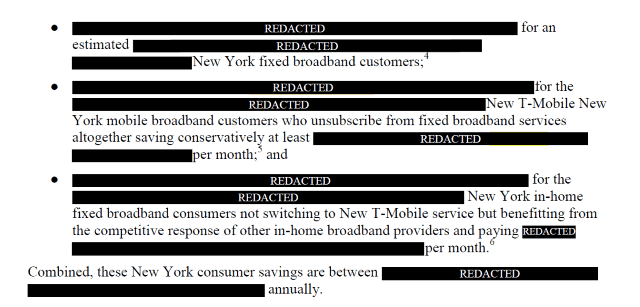
Sprint and T-Mobile’s arguments regarding the consumer benefits of its merger for New Yorkers remain a public mystery. The companies redacted this submission to keep the prying eyes of average consumers from reading it.
The CWA and PULP are asking the Commission for an order that:
1) Requires the Joint Applicants to provide unredacted submissions or to withdraw any document relying on redactions; and/or
2) Convenes an evidentiary hearing permitting examination and testimony relating to the Petition and the submission; and/or
3) Grants our previous request for a formal Public Hearing on the Petition and the submission; and/or
4) Removes from the record the Joint Applicants’ November 16 submission from the record; and/or
5) Extends the deadline for Notice and Comment in the October 19 Order to December 15, 2018; and/or such other relief as the Commission may order.
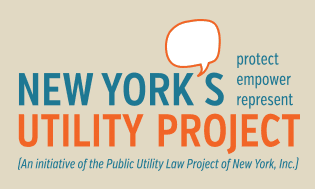 The merger of the two wireless companies requires state and federal approval. Alaska, Colorado, Delaware, Georgia, Louisiana, Maryland, Minnesota, Nevada, Texas, Utah, West Virginia and the District of Columbia have already essentially “rubber-stamped” approval of the merger deal with little comment. Pennsylvania regulators submitted a series of questions that the two companies answered earlier this week.
The merger of the two wireless companies requires state and federal approval. Alaska, Colorado, Delaware, Georgia, Louisiana, Maryland, Minnesota, Nevada, Texas, Utah, West Virginia and the District of Columbia have already essentially “rubber-stamped” approval of the merger deal with little comment. Pennsylvania regulators submitted a series of questions that the two companies answered earlier this week.
Sprint and T-Mobile are having a tougher time dealing with regulators in New York and New Jersey, however — the two most likely to either deny approval or impose significant deal conditions in approving the transaction. A review is pending in California, which routinely asks a lot of questions but rarely opposes telecommunications company mergers. Hawaii and Mississippi will also examine the merger in the near future, but neither are expected to oppose it.
New York regulators are likely to consider the impact of the merger on the availability of affordable cellphone plans, the Lifeline program that offers discounted phone service for the poor, and how the transaction will affect rural wireless service in upstate New York.


 Subscribe
Subscribe
 Pai says giving companies like Verizon the permanent right to manage the kinds of text messages allowed on their networks is a good way to stop texting spam.
Pai says giving companies like Verizon the permanent right to manage the kinds of text messages allowed on their networks is a good way to stop texting spam.
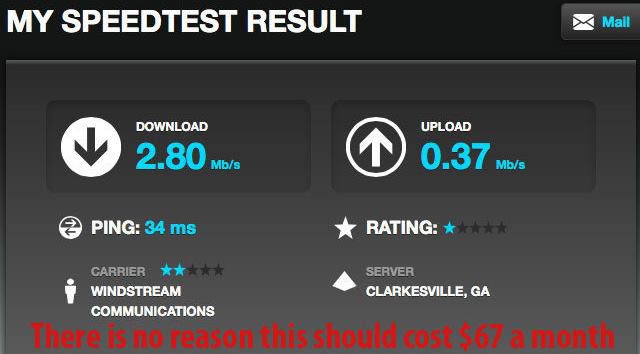
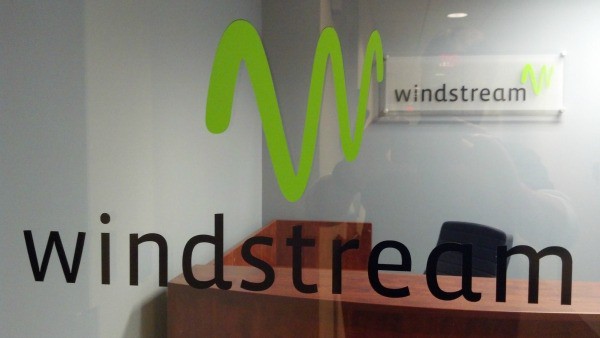 “It took a service technician coming out to make it clear to us there was no way we would ever get faster speed because there was too much copper wiring between their office and our homes,” Brown said. “The technician felt for us, and about half of his service calls were disappointing customers like us.”
“It took a service technician coming out to make it clear to us there was no way we would ever get faster speed because there was too much copper wiring between their office and our homes,” Brown said. “The technician felt for us, and about half of his service calls were disappointing customers like us.”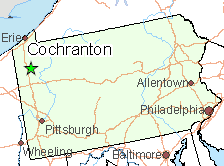 “We are paying for internet speed that we aren’t receiving,” Ruth complained. “It is so slow that we have a hard time getting a short 50 second video to load. Forget watching a YouTube video, it’s not going to happen.”
“We are paying for internet speed that we aren’t receiving,” Ruth complained. “It is so slow that we have a hard time getting a short 50 second video to load. Forget watching a YouTube video, it’s not going to happen.” Wall Street balks at the dollar amounts it would take for Windstream to fully update its network to offer broadband speeds that were common for cable subscribers a decade ago. That kind of network investment would likely drive down the share price, impact shareholder dividends or stock buyback plans, and increase debt. Instead, many phone companies are hoping the federal government will come to the rescue and subsidize rural network improvements through the FCC’s Connect America Fund or government grants. But many of those grants won’t deliver service improvements to existing customers. Instead it will allow rural phone companies to bring broadband to customers who never had it before.
Wall Street balks at the dollar amounts it would take for Windstream to fully update its network to offer broadband speeds that were common for cable subscribers a decade ago. That kind of network investment would likely drive down the share price, impact shareholder dividends or stock buyback plans, and increase debt. Instead, many phone companies are hoping the federal government will come to the rescue and subsidize rural network improvements through the FCC’s Connect America Fund or government grants. But many of those grants won’t deliver service improvements to existing customers. Instead it will allow rural phone companies to bring broadband to customers who never had it before.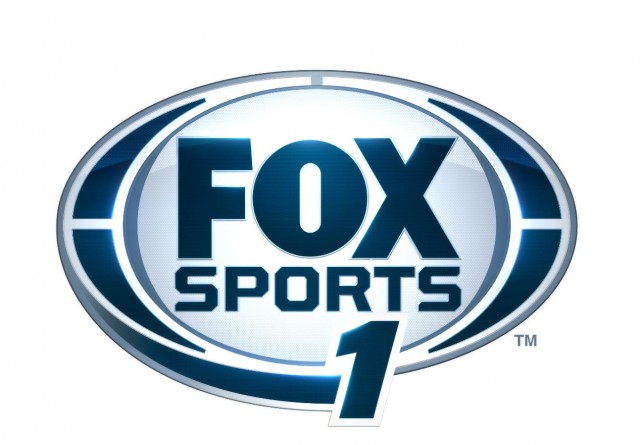 Amazon wants to be a major player in live regional sports television, aggressively bidding for the 22 regional sports network that Disney acquired from 21st Century Fox, according to
Amazon wants to be a major player in live regional sports television, aggressively bidding for the 22 regional sports network that Disney acquired from 21st Century Fox, according to 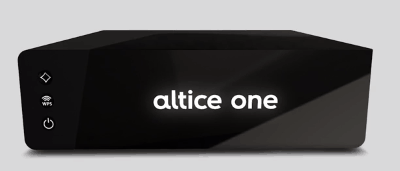 Altice USA is upgrading the firmware powering its much-promoted Altice One set-top box to introduce new functionality and integrate popular web services into the viewing experience.
Altice USA is upgrading the firmware powering its much-promoted Altice One set-top box to introduce new functionality and integrate popular web services into the viewing experience.